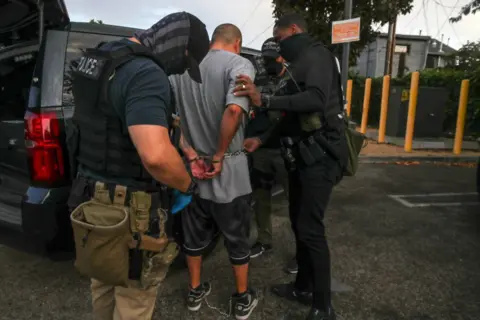How effective will Trump’s promise to deport migrants en masse work?

 Getty Images
Getty ImagesIf re-elected president, Donald Trump has promised to deport en masse those who do not have legal permission to stay in the United States.
While his campaign has offered varying answers about how many people could be removed, his vice presidential running mate JD Vance offered only one number in an interview with ABC News this week.
“Let’s start with a million,” he said. “That’s where Kamala Harris failed. And then we can go from there.”
But even as this became a key cornerstone of Trump’s campaign platform — with signs at his rallies reading “Mass Deportation Now!” — experts say there are still significant legal and practical challenges to deporting so many people.
What are the legal challenges?
The latest figures from the Department of Homeland Security and Pew Research show that there are now about 11 million undocumented immigrants living in the United States, a number that has remained relatively stable since 2005.
Most are long-term residents — nearly four-fifths have been in the country for more than a decade.
Immigrants who are in the country without legal status have the right to due process, including a court hearing, before they are deported. A sharp increase in deportations would likely result in a significant expansion of the already backlogged immigration court system.
Most immigrants already in this country enter the deportation system not through encounters with Immigration and Customs Enforcement (ICE) agents but through local law enforcement.
However, many of the country’s largest cities and counties have passed laws restricting local police cooperation with Ice.
The Trump campaign has pledged to take action against these “sanctuary cities,” but the United States’ tangled web of local, state and federal laws complicates the picture.
Kathleen Bush-Joseph, a policy analyst at the Washington-based Migration Policy Institute, or MPI, said cooperation between ICE and local officials would be a “critical” aspect of any mass deportation program.
“It would be much easier for Ice to arrest someone in jail if local law enforcement cooperated, rather than having to go find them themselves,” she said.
Bush-Joseph cited an early August statement from the sheriff’s offices of Broward and Palm Beach counties in Florida, in which they said they would not deploy police to support any mass deportation plans.
“There are a lot of other people who are not going to cooperate with Trump’s mass deportation plan,” she said. “That makes things a lot more difficult.”
Any mass deportation program would likely immediately face a barrage of legal challenges from immigration and human rights activists.
However, a 2022 Supreme Court ruling means the court cannot issue an injunction against immigration enforcement policies — meaning the injunction will continue even if challenges are resolved through the legal system.
 Getty Images
Getty ImagesBut is that logistically possible?
Even if the US government could legally carry out a mass deportation plan, authorities would still face enormous logistical challenges.
Under the Biden administration, deportation efforts have focused on migrants recently detained at the border. Migrants being expelled from farther inland, from areas not near the border, are largely those with criminal records or deemed national security threats.
Controversial raids on construction sites carried out under the Trump administration were suspended in 2021.
Deportations of people apprehended in the interior of the United States — as opposed to those at the border — have remained below 100,000 for a decade, after peaking at more than 230,000 in the early years of the Obama administration.
“To increase that number in one year would require a huge amount of resources that may not exist,” Aaron Reichlin-Melnick, policy director at the American Immigration Council, told the BBC.
First, experts suspect that Ice’s 20,000 agents and support staff would not be enough to find and track even a fraction of the numbers the Trump campaign is putting out.
The deportation process is long and complicated and only begins with identifying and apprehending undocumented migrants, Reichlin-Melnick added.
Detainees would then need to be relocated or placed in an “alternative to detention” program before they are brought before an immigration judge, in a system with years-long backlogs.
Only then can detainees be removed from the United States, a process that requires diplomatic cooperation from the receiving country.
“In each of those areas, Ice doesn’t have the capacity to handle millions of people,” Reichlin-Melnick said.
Trump has said he will mobilize the National Guard or other US military forces to assist with deportations.
Traditionally, the U.S. military’s role in immigration issues has been limited to supporting functions at the U.S.-Mexico border.
Beyond using the military and “using local law enforcement,” Trump offered few specifics on how such a mass deportation plan would be carried out.
In an interview with Time magazine earlier this year, the former president said only that he “would not rule out” building new migrant detention facilities and that he would work to make police immune from prosecution by “liberal groups or progressive groups.”
There may also be incentives for state and local police departments to participate, he added, and those who don’t “won’t benefit.”
“We have to do this,” he said. “This is not sustainable for our country.”
The BBC has contacted the Trump campaign for further comment.
Eric Ruark, research director at NumbersUSA — an organization that advocates for tighter immigration controls — said any internal deportation program would only be effective if accompanied by increased enforcement at the border.
“That has to be the top priority. You’re not going to make much progress on the interior if it’s not,” he said. “That’s what keeps people coming.”
In addition, Mr. Ruark said a crackdown on companies that recruit undocumented migrants was also necessary.
“They come here to find jobs,” he said. “And they get those jobs because law enforcement in the country has basically been dismantled.”
 Getty Images
Getty ImagesFinancial and political costs
Experts estimate the total cost of a million or more deportations would run into the tens or even hundreds of billions of dollars.
Ice’s budget for transport and deportation in 2023 was $420m (£327m). In that year, the agency deported more than 140,000 people.
Thousands of immigrants will be detained pending trial or deportation, and the Trump campaign envisioned building massive refugee camps to house them all.
The number of evacuation flights would also need to increase significantly, possibly requiring military aircraft to augment current capacity.
Even a small expansion in any of these areas can result in significant costs.
“Even a small change is tens of millions, or hundreds of millions,” said Reichlin-Melnick. “A significant change is tens or hundreds of millions.”
Those costs would be added to the costs of other border enforcement efforts Trump has promised: continuing construction of a wall along the southern border of the United States, closing the sea lanes to prevent fentanyl from entering the country and deploying thousands of troops to the border.
Adam Isacson, a migration and border expert at the Washington Office on Latin America, said the “horrifying images” of mass deportations could also cost a potential Trump administration politically from a public relations standpoint.
“Every community in America will see people they know and love put on buses,” said Isacson.
“You’ll see some very painful images on TV of children crying and families,” he added. “All of that is extremely bad journalism. It’s family separation, but intensified.”
Has there ever been a mass deportation before?
During the four years of the previous Trump administration, about 1.5 million people were deported, both at the border and within the United States.
Statistics show the Biden administration — which has deported about 1.1 million people through February 2024 — is on track to meet that goal.
During the Obama administration’s two terms — when Mr Biden was vice president — more than three million people were deported, leading some immigration reform advocates to call Barack Obama the “deporter in chief”.
The only historical comparison to the mass deportation program came in 1954, when up to 1.3 million people were deported as part of Operation Wetback, named after an insult commonly used to refer to Mexicans at the time.
However, that figure is still disputed by historians.
The program, under President Dwight Eisenhower, faced significant public opposition—in part because some US citizens were also being deported—as well as a lack of funding. The program was largely discontinued in 1955.
Immigration experts say the previous operation focused on Mexican nationals and lacked due process, making it incomparable to a modern mass deportation program.
“Those other things [deported in the 1950s] are single Mexican men,” said Kathleen Bush-Joseph of MPI.
“Right now, the majority of people coming through ports of entry are coming from places other than Mexico, or even northern Central America. That makes it much more difficult to get them back,” she added.
“Those are not comparable situations.”





